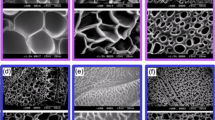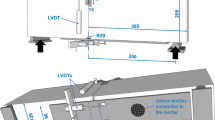Abstract
We report the synthesis and characterization of biobased superabsorbent copolymers from κ-carrageenan and poly(acrylic acid) that mitigate autogenous shrinkage in ordinary portland cement paste. Synthesized via free radical graft polymerization, the biobased superabsorbent polymers (SAPs) were characterized with regard to their thermochemical properties and swelling behavior in both aqueous and ionic solutions. The biobased SAPs were incorporated into cement paste to investigate their ability to mitigate autogenous shrinkage cracking in high-performance concrete. Results demonstrate that the biobased SAPs absorb up to 438 and 94 [g/g] (by mass) in aqueous and ionic solutions, respectively, after 24 h. Furthermore, the biobased SAPs were successful in mitigating shrinkage in low water-to-cement ratio pastes. While the control paste exhibited negative strain and ultimate shrinkage cracking, the samples containing biobased SAP experienced net-positive expansion during cement hydration.








Similar content being viewed by others
References
Snoeck D, Jensen OM, De Belie N (2015) The influence of superabsorbent polymers on the autogenous shrinkage properties of cement pastes with supplementary cementitious materials. Cem Concr Res 74:59–67. https://doi.org/10.1016/j.cemconres.2015.03.020
Mechtcherine V, Gorges M, Schroefl C, Assmann A, Brameshuber W, Ribeiro AB, Cusson D, Custódio J, Da Silva EF, Ichimiya K, Igarashi SI, Klemm A, Kovler K, De Mendonça Lopes AN, Lura P, Nguyen VT, Reinhardt HW, Filho RDT, Weiss J, Wyrzykowski M, Ye G, Zhutovsky S (2014) Effect of internal curing by using superabsorbent polymers (SAP) on autogenous shrinkage and other properties of a high-performance fine-grained concrete: results of a RILEM round-robin test. Mater Struct Constr 47:541–562. https://doi.org/10.1617/s11527-013-0078-5
Laustsen S, Hasholt MT, Jensen OM (2015) Void structure of concrete with superabsorbent polymers and its relation to frost resistance of concrete. Mater Struct 48:357–368. https://doi.org/10.1617/s11527-013-0188-0
Mönnig S, Lura P (2007) Superabsorbent polymers—an additive to increase the freeze-thaw resistance of high strength concrete. In: Grosse CU (ed) Advances in construction materials, pp 351–358. https://doi.org/10.1007/978-3-540-72448-3
Mechtcherine V, Schröfl C, Wyrzykowski M, Gorges M, Lura P, Cusson D, Margeson J, De Belie N, Snoeck D, Ichimiya K, Igarashi SI, Falikman V, Friedrich S, Bokern J, Kara P, Marciniak A, Reinhardt HW, Sippel S, Bettencourt Ribeiro A, Custódio J, Ye G, Dong H, Weiss J (2017) Effect of superabsorbent polymers (SAP) on the freeze–thaw resistance of concrete: results of a RILEM interlaboratory study. Mater Struct Constr. https://doi.org/10.1617/s11527-016-0868-7
Mignon A, Graulus GJ, Snoeck D, Martins J, De Belie N, Dubruel P, Van Vlierberghe S (2014) pH-sensitive superabsorbent polymers: a potential candidate material for self-healing concrete. J Mater Sci 50:970–979. https://doi.org/10.1007/s10853-014-8657-6
Snoeck D, Van Tittelboom K, Steuperaert S, Dubruel P, De Belie N (2014) Self-healing cementitious materials by the combination of microfibres and superabsorbent polymers. J Intell Mater Syst Struct 25:13–24. https://doi.org/10.1177/1045389X12438623
Zhu Q, Barney CW, Erk KA (2015) Effect of ionic crosslinking on the swelling and mechanical response of model superabsorbent polymer hydrogels for internally cured concrete. Mater Struct 48:2261–2276. https://doi.org/10.1617/s11527-014-0308-5
Zhang J, Wang Q, Wang A (2007) Synthesis and characterization of chitosan-g-poly(acrylic acid)/attapulgite superabsorbent composites. Carbohydr Polym 68:367–374. https://doi.org/10.1016/j.carbpol.2006.11.018
Pourjavadi A, Fakoorpoor SM, Hosseini P, Khaloo A (2013) Interactions between superabsorbent polymers and cement-based composites incorporating colloidal silica nanoparticles. Cem Concr Compos 37:196–204. https://doi.org/10.1016/j.cemconcomp.2012.10.005
Zohuriaan-Mehr MJ, Kabiri K (2008) Superabsorbent polymer materials, Iran. Polym J 17:451–477. http://www.sid.ir/En/Journal/ViewPaper.aspx?ID=109597
Ahmed EM (2015) Hydrogel: preparation, characterization, and applications: a review. J Adv Res 6:105–121. https://doi.org/10.1016/j.jare.2013.07.006
Buchholz FL, Graham AT (1998) Modern superabsorbent polymer technology. Wiley-VCH, New York
Feng E, Ma G, Wu Y, Wang H, Lei Z (2014) Preparation and properties of organic-inorganic composite superabsorbent based on xanthan gum and loess. Carbohydr Polym 111:463–468. https://doi.org/10.1016/j.carbpol.2014.04.031
Bhardwaj TR, Kanwar M, Lal R, Gupta A (2000) Natural gums and modified natural gums as sustained-release carriers. Drug Dev Ind Pharm 26:1025–1038. https://doi.org/10.1081/DDC-100100266
Manuhara GJ, Praseptiangga D, Riyanto RA (2016) Extraction and characterization of refined K-carrageenan of red algae [Kappaphycus alvarezii (Doty ex P.C. Silva, 1996)] originated from Karimun Jawa Islands. Aquat Procedia 7:106–111. https://doi.org/10.1016/j.aqpro.2016.07.014
Rostamnia S, Doustkhah E, Baghban A, Zeynizadeh B (2016) Seaweed-derived κ-carrageenan: modified κ-carrageenan as a recyclable green catalyst in the multicomponent synthesis of aminophosphonates and polyhydroquinolines. J Appl Polym Sci 133:1–7. https://doi.org/10.1002/app.43190
Campo VL, Kawano DF, da Silva DB, Carvalho I (2009) Carrageenans: biological properties, chemical modifications and structural analysis—a review. Carbohydr Polym 77:167–180. https://doi.org/10.1016/j.carbpol.2009.01.020
Chronakis IS, Piculell L, Borgström J (1996) Rheology of kappa-carrageenan in mixtures of sodium and cesium iodide: two types of gels. Carbohydr Polym 31:215–225. https://doi.org/10.1016/S0144-8617(96)00117-8
Liu S, Li L (2016) Thermoreversible gelation and scaling behavior of Ca2+-induced??-carrageenan hydrogels. Food Hydrocoll 61:793–800. https://doi.org/10.1016/j.foodhyd.2016.07.003
Wang F, Zhou Y, Peng B, Liu Z, Hu S (2009) Autogenous shrinkage of concrete with super-absorbent polymer. ACI Mater J 106:123–127
Jensen OM, Hansen PF (2001) Water-entrained cement-based materials—I. Principles and theoretical background. Cem Concr Res 31:647–654. https://doi.org/10.1016/S0008-8846(01)00463-X
Bentur A, Igarashi SI, Kovler K (2001) Prevention of autogenous shrinkage in high-strength concrete by internal curing using wet lightweight aggregates. Cem Concr Res 31:1587–1591. https://doi.org/10.1016/S0008-8846(01)00608-1
Mechtcherine V, Reinhardt H-W (eds) (2012) Application of superabsorbent polymers (SAP) in concrete construction: state-of-the-art report prepared by Technical Committee 225-SAP. https://doi.org/10.1007/978-94-007-2733-5
Weber S, Reinhardt HW (1997) A new generation of high performance concrete: concrete with autogenous curing. Adv Cem Based Mater 6:59–68. https://doi.org/10.1016/S1065-7355(97)00009-6
Mechtcherine V, Snoeck D, Schröfl C, De Belie N, Klemm AJ, Ichimiya K, Moon J, Wyrzykowski M, Lura P, Toropovs N, Assmann A, Igarashi S, De La Varga I, Almeida FCR, Erk K, Ribeiro AB, Custódio J, Reinhardt HW, Falikman V (2018) Testing superabsorbent polymer (SAP) sorption properties prior to implementation in concrete: results of a RILEM Round-Robin Test. Mater Struct 51:28. https://doi.org/10.1617/s11527-018-1149-4
Schröfl C, Snoeck D, Mechtcherine V (2017) A review of characterisation methods for superabsorbent polymer (SAP) samples to be used in cement-based construction materials: report of the RILEM TC 260-RSC. Mater Struct Constr. https://doi.org/10.1617/s11527-017-1060-4
Ghods P, Isgor OB, McRae G, Miller T (2009) The effect of concrete pore solution composition on the quality of passive oxide films on black steel reinforcement. Cem Concr Compos 31:2–11. https://doi.org/10.1016/j.cemconcomp.2008.10.003
Krafcik MJ, Erk KA (2016) Characterization of superabsorbent poly(sodium-acrylate acrylamide) hydrogels and influence of chemical structure on internally cured mortar. Mater Struct 49:4765–4778. https://doi.org/10.1617/s11527-016-0823-7
Justs J, Wyrzykowski M, Winnefeld F, Bajare D, Lura P (2014) Influence of superabsorbent polymers on hydration of cement pastes with low water-to-binder ratio: a calorimetry study. J Therm Anal Calorim 115:425–432. https://doi.org/10.1007/s10973-013-3359-x
Jensen OM, Hansen PF (2002) Water-entrained cement-based materials: II. Experimental observations. Cem Concr Res 32:973–978. https://doi.org/10.1016/S0008-8846(02)00737-8
Kantro DL (1980) Influence of water-reducing admixtures on properties of cement paste—a miniature slump test. Cem Concr Aggreg. 2:95–102. doi: http://dx.doi.org/10.1520/CCA10190J. ISSN 0149-6123
Pourjavadi A, Harzandi AM, Hosseinzadeh H (2004) Modified carrageenan 3. Synthesis of a novel polysaccharide-based superabsorbent hydrogel via graft copolymerization of acrylic acid onto kappa-carrageenan in air. Eur Polym J 40:1363–1370. https://doi.org/10.1016/j.eurpolymj.2004.02.016
Eisenberg A, Yokoyama T (1969) Dehydration kinetics and glass transition of poly(acrylic acid). J Polym Sci 7:1717–1728
Mitsuiki M, Yamamoto Y, Mizuno A, Motoki M (1998) Glass transition properties as a function of water content for various low-moisture galactans. J Agric Food Chem 46:3528–3534. https://doi.org/10.1021/jf9709820
Blanshard JMV, Lillford P, Easter S (1993) School in agricultural science (53rd: 1992: Nottingham University), the glassy state in foods, Nottingham University Press. https://espace.library.uq.edu.au/view/UQ:236984#.WiBdrtx65fw.mendeley. Accessed 30 Nov 2017
Frazier SD, Srubar WV (2016) Evaporation-based method for preparing gelatin foams with aligned tubular pore structures. Mater Sci Eng C 62:467–473. https://doi.org/10.1016/j.msec.2016.01.074
Carrageenan (Red Seaweed), (n.d.). http://www.cargohandbook.com/index.php/Carrageenan_(Red_Seaweed). Accessed 16 Nov 2017
Shawe J, Riesen R, Widmann J, Schubnell M (2000) UserCom. Mettler Toledo, p 1–28. https://www.mt.com/us/en/home/library/usercoms/lab-analytical-instruments/TA_UserCom11.html. Accessed 15 Nov 2017
Chopin T, Whalen E (1993) A new and rapid method for carrageenan identification by FT IR diffuse reflectance spectroscopy directly on dried, ground algal material. Carbohydr Res 246:51–59. https://doi.org/10.1016/0008-6215(93)84023-Y
Kirwan LJ, Fawell PD, Van Bronswijk W (2003) In situ FTIR-ATR examination of poly(acrylic acid) adsorbed onto hematite at low pH. Langmuir 19:5802–5807. https://doi.org/10.1021/la027012d
Schröfl C, Mechtcherine V, Gorges M (2012) Relation between the molecular structure and the efficiency of superabsorbent polymers (SAP) as concrete admixture to mitigate autogenous shrinkage. Cem Concr Res 42:865–873. https://doi.org/10.1016/j.cemconres.2012.03.011
Krafcik MJ, Macke ND, Erk KA (2017) Improved concrete materials with hydrogel-based internal curing agents. Gels 3:46. https://doi.org/10.3390/gels3040046
Plank J, Sachsenhauser B (2009) Experimental determination of the effective anionic charge density of polycarboxylate superplasticizers in cement pore solution. Cem Concr Res 39:1–5. https://doi.org/10.1016/j.cemconres.2008.09.001
Therkelsen GH, Carrageenan (1993) In: Industrial gums. Elsevier, pp 145–180. https://doi.org/10.1016/B978-0-08-092654-4.50011-5
Kara S, Tamerler C, Pekcan Ö (2003) Cation effects on swelling of κ-carrageenan: a photon transmission study. Biopolymers 70:240–251. https://doi.org/10.1002/bip.10467
Esteves LP (2011) Superabsorbent polymers: on their interaction with water and pore fluid. Cem Concr Compos 33:717–724. https://doi.org/10.1016/j.cemconcomp.2011.04.006
Justs J, Wyrzykowski M, Bajare D, Lura P (2015) Internal curing by superabsorbent polymers in ultra-high performance concrete. Cem Concr Res 76:82–90. https://doi.org/10.1016/j.cemconres.2015.05.005
Acknowledgements
This research was made possible by the Department of Civil, Environmental, and Architectural Engineering, the College of Engineering and Applied Sciences, and the Sustainable Infrastructure Materials Laboratory (SIMLab) at the University of Colorado Boulder with support from the from the National Science Foundation (Award No. CMMI-1562557). The authors would like to thank Shane Frazier for DSC data collection and Elizabeth Delesky for data collection during time-of-set testing. This work represents the views of the authors and not necessarily those of the sponsors.
Funding
This study was funded in part by the US National Science Foundation (Award No. CMMI-1562557).
Author information
Authors and Affiliations
Corresponding author
Ethics declarations
Conflict of interest
The authors declare that they have no conflict of interest.
Rights and permissions
About this article
Cite this article
Aday, A.N., Osio-Norgaard, J., Foster, K.E.O. et al. Carrageenan-based superabsorbent biopolymers mitigate autogenous shrinkage in ordinary portland cement. Mater Struct 51, 37 (2018). https://doi.org/10.1617/s11527-018-1164-5
Received:
Accepted:
Published:
DOI: https://doi.org/10.1617/s11527-018-1164-5




